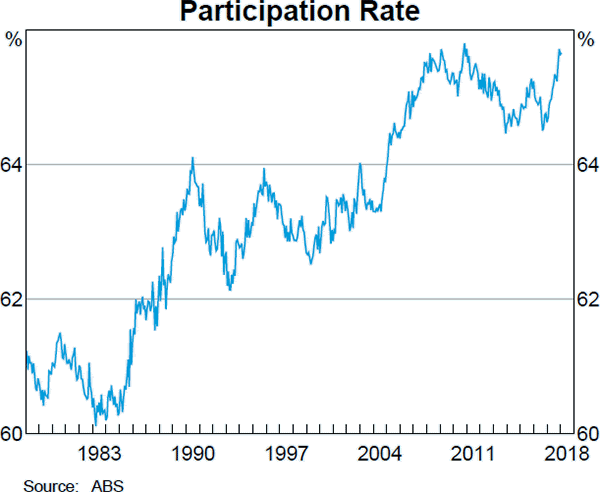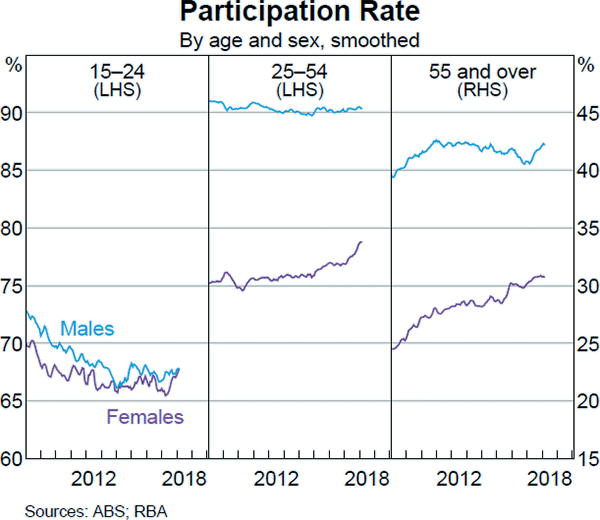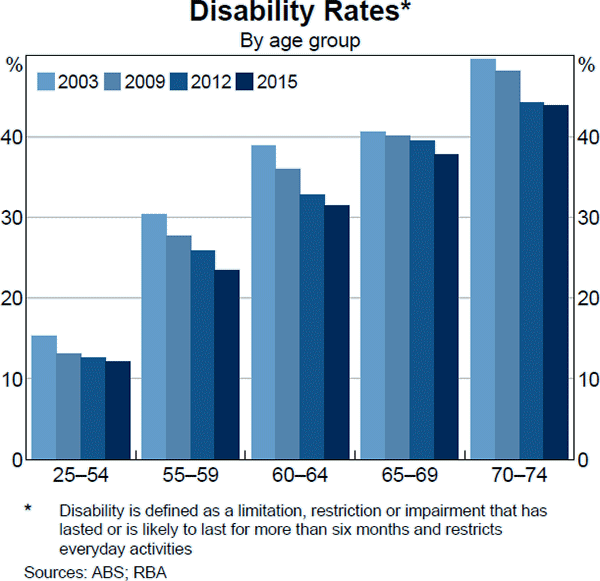Statement on Monetary Policy – May 2018 Box B: The Recent Increase in Labour Force Participation
There has been a sharp increase in the labour force participation rate recently (Graph B1).[1] Since September 2016, the participation rate has increased by 1.1 percentage points to 65.5 per cent, which is close to its highest level on record. This increase has been driven by higher participation of females – particularly those aged between 25 and 54 years – and older males (Graph B2). The long-run upward trend in the participation rate of women aged over 25 years has accelerated recently. In contrast, the participation rates of younger people of both sexes are below their levels of a decade ago.
Cyclical factors are likely to have contributed to the increase in labour force participation. The demand for labour has risen strongly since September 2016, with total hours worked increasing at an annualised rate of 2.8 per cent. This is likely to have encouraged some people to commence searching for work. Strong labour market conditions are also likely to have encouraged workers to delay leaving the labour force (such as for retirement). This is consistent with the pattern of increases in participation, in that the groups that have increased their participation the most over the recent period are the groups whose participation tends to rise when labour market conditions are stronger.
Structural and longer-term factors may also have supported the recent increase in labour force participation of older workers. The age at which people can access the age pension was increased from 65 to 65½ years in July 2017, so older workers will tend to remain in the labour force for a bit longer. The increase in the preservation age at which workers can access their superannuation will also be influencing retirement decisions. Looking over a longer period, the health of older people has tended to improve, enabling more of them to remain in the labour force for longer, and an increasing share of employment is now in occupations that are generally less physically demanding. Data from the HILDA survey indicate that, on average over 2014–16, fewer older people reported themselves as being in poor health compared to 2001–03.[2] Older people who reported themselves as in good health were around twice as likely to participate in the labour force as those in poor health. A similar decline is apparent in disability rates amongst older people (Graph B3).



Previous RBA work has found that the probability of females being in the labour force has increased since the global financial crisis.[3] This reflects a range of factors including changes in work preferences and perceptions of traditional gender roles, as well as increased flexibility of hours worked both through the increased availability of part-time employment and flexibility within full-time jobs. The need to increase household income to manage household debt may also have contributed.
The types of jobs that have been created since mid 2016 are also likely to have encouraged more labour force participation. Employment growth has been very strong in the healthcare and social assistance industry; the number of people employed in this industry increased by more than 150,000 over the year to February 2018, accounting for more than one-third of total employment growth over that period. This may have supported increases in the participation rate because healthcare and social assistance employment is more likely than other industries to draw on workers from outside the labour force. Evidence from the HILDA survey suggests that nearly half of those who join healthcare employment from outside the labour force were women aged between 25 and 44 years.
The rollout of the National Disability Insurance Scheme over the next few years and the gradual ageing of the population are both expected to continue to boost employment in health care and social assistance. This may continue to provide support to labour force participation. The gradual increases in the age at which workers can access the pension or superannuation, rising longevity and changes in the demographic composition of the labour force will also affect the participation rate. However, labour market conditions are likely to remain an important influence on the participation rate over the next few years.
Footnotes
The participation rate measures the share of people aged 15 and over that are either working or looking for work. [1]
This box uses unit record data from the Household, Income and Labour Dynamics in Australia (HILDA) Survey. For more information, see Copyright and Disclaimers Notice. [2]
See van der Merwe M (2016), ‘Factors Affecting an Individual's Future Labour Market Status’, RBA Bulletin, December, pp 11–22. [3]